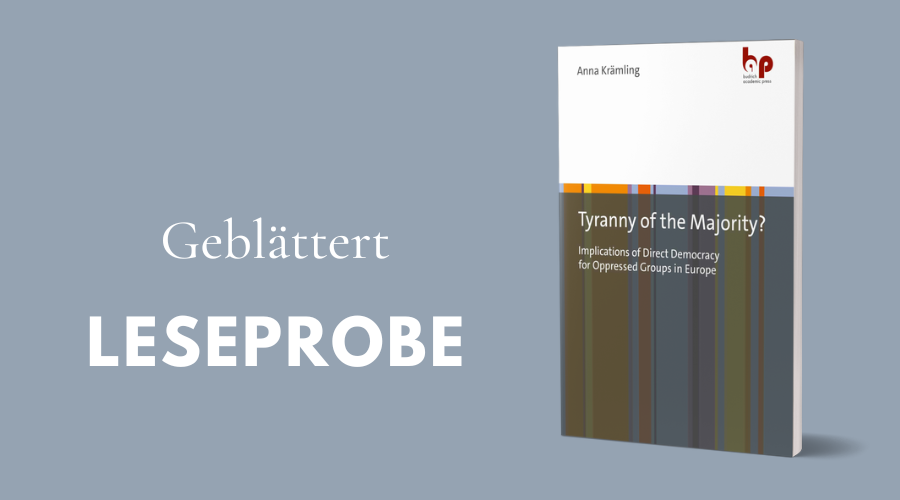Endet direkte Demokratie in einer Tyrannei der Mehrheit über Minderheiten? Diese erstmalige Untersuchung von über 500 Volksabstimmungen von Anna Krämling zeigt, dass Minderheiten im Gegenteil oft von direkter Demokratie profitieren konnten. Gefährdet sind aber die Interessen der queeren Community, Menschen mit niedrigem sozioökonomischem Status und ausländischen Personen. In ihrer Publikation „Tyranny of the Majority? Implications of Direct Democracy for Oppressed Groups in Europe“ zeigt Anna Kärmling Wege zur Gestaltung minderheitenfreundlicher Abstimmungen aufgezeigt.
Auf unserem englischsprachigen Blog ist nun eine Leseprobe aus dem Buch abrufbar: www.budrich.de/en/news/reading-sample-tyranny-majority-anna-kraemling
Über das Buch „Tyranny of the Majority? Implications of Direct Democracy for Oppressed Groups in Europe“
Increased political influence of citizens through direct democratic votes – that does sound promising in times of growing political dissatisfaction and support for extremist parties. Yet, what does direct democracy with its majoritarian decision-making imply for Oppressed Groups? Previous research offered a mixed picture. Therefore, this book for the first time analyses all national-level direct democratic votes in Europe over 25 years. To arrive at an encompassing and differentiated overview, the author uses the concept of Oppressed Groups by Iris M. Young instead of the term minorities, which is often applied but only vaguely specified in research on direct democracy. The results show that Oppressed Groups were often able to actually benefit from direct democracy. Bills supporting their interests more often came to a vote than those disadvantaging them, and supporting bills also were more likely to be adopted at the ballot than their disadvantaging counterparts. However, this does not hold for a majority of bills affecting members of the LGBTQ+ community, groups of low socioeconomic status, and people without the citizenship of the country they live in. Based on further empirical analyses, the book as a result develops suggestions about how to design direct democratic votes to empower Oppressed Groups. Quite surprisingly, binding vote results and the absence of voting thresholds promote the success of bills supporting Oppressed Groups while at the same time lower the likelihood of success for damaging bills. The book also stresses the role of resources and attitudes in these votes and the necessity to support groups at a disadvantage in these regards. In doing so, the book addresses a long-lasting research gap and contributes to the academic as well as to the political debate on direct democracy.


